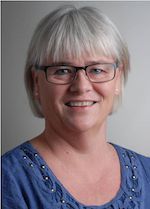HealthManagement, Volume 13 - Issue 3, 2013
How
Can Leadership Encourage Radiologists, Secretaries, Radiographers,
Clinicians, and Nurses to Develop Innovative Patient Pathways?
Authors
DrAgnete Hedemann NielsenMD Radiology,
Diagnostic Centre, University Research, Clinic for Innovative Patient Pathways
Silkeborg Regional Hospital, Denmark

Annette Meyer Balle
Radiographer
Diagnostic Centre, University Research,Clinic for Innovative Patient Pathways
Silkeborg Regional Hospital, Denmark
Susanne Skovlund Petersen
Medical Secretary
Diagnostic Centre, University Research, Clinic for Innovative Patient Pathways
Silkeborg Regional Hospital, Denmark

Rikke Aarhus
MA Anthropology
Diagnostic Centre, University Research, Clinic for Innovative Patient Pathways
Silkeborg Regional Hospital, Denmark
Key Points
- Leadership has to be redesigned to overcome the knowing-doing gap and make changes happen fast and viably.
- Development of new patient pathways should be carried out by staff members taking part in the patient pathway.
- Plastic organic groups’ is a cross-disciplinary work method to integrate development in daily clinical practice and overcome common barriers.
In our institution the radiology department was thought to be very conservative, and an obstruction when implementing new research results and optimising patient pathways. Earlier approaches to solve the problem, relying on established hierarchical work methods, had not proved successful. Out of necessity and to solve the knowingdoing gap, leadership had to be redesigned and an innovative work approach had to be embedded in daily clinical work. In order to establish partnership between professions and departments, management and leadership had to be enacted in an ‘unbossed’ way creating an urge among staff to become involved in development processes. Based on this, and to reduce the knowing-doing gap, we developed a work method, called ‘plastic organic group’ (PO-group). The groups were named plastic organic groups to envision that the shape of the groups, ie the participants and the topic, can change over time. The only thing that cannot change is the focus on the general optimisation of the specific patient pathway. The work method includes elements from e.g. Clinical microsystems, Lean, and Breakthrough improvement.
The PO-group method was first applied when acknowledging a quality defect in the treatment of Transient Cerebral Ischaemic attack (TCI). Before the first meeting the quality measurements were only met in 70% of patients. In a few weeks they had changed and were met in 100%, and over one year the whole concept of treating and evaluating these patients had changed. This led to a remarkable reduction in length of stay, including reduced time used for diagnosis and for initiating treatment. Altogether this had a great impact on not only the department’s but the hospital’s economy.
Plastic Organic Groups as an Innovative Work Method
A PO-group is focused on redesigning a patient pathway. The staff members across hospital departments involved in the pathway in question are invited to participate, but are not appointed by management. Hence, participation does not require approval by a manager. The work method schedules short (15 minutes) weekly meetings with minutes but no agenda. It is an iterative method, focused on fast stepwise changes with a longrange goal with potentially changing endpoints. A meeting in a plastic organic group always takes place at the same time and in the same room to ease participation. The work method challenges the intuitive or preconscious reluctance to challenge routines, and over time minimises the opposition to changes in daily practice, which is a known barrier for implementing new knowledge. Implementing new ideas this way as trial actions is more acceptable, as they can be tried in practice, and, if not working, rolled back within a week, i.e. at the next meeting.
Another common obstacle to engaging staff in innovation and in developing new ideas is said to be the time taken from patient care. Rather than turning to the common solution of this problem; that the manager who is not involved in direct patient care redesigns the new patient pathways, a PO-group makes it possible for clinical staff to be engaged and involved directly in the change process. By reducing the meeting time, making minutes available for all involved and making the meeting point and hour known to everybody, it becomes possible for staff members to participate. It is important that everybody knows that although you are part of redesigning the pathway as such you may, if wished, only participate when your expertise is necessary for the next step. In this way, redesigning and rethinking pathways can be part of daily clinical practice integrated on equal terms with other duties such as X-ray examinations.
Leadership in Plastic Organic Groups
Working with PO-groups challenges the archetypal hierarchical management often seen in hospitals, and the negative impact of hierarchies and department boundaries is reduced. Leadership is of utmost importance to do this. On an overall level, leadership is required to create and enact a culture where focus is removed from today’s survival to fundamental improvements, and where staff members have freedom to act. Furthermore, short decision- making processes are needed as well as a willingness to add a focus on quality to the common managerial focus on economy. Finally, a leadership signalling change and a strong belief in staff members’ competences is mandatory.
PO-groups emphasise partnership, and hence leadership is also needed to establish a room for discussion where all staff members, though having different education, participate on the same ground with their specific professional insight. It requires that leadership both emphasises and acknowledges the value of each contributor.
In regard to the specific PO-groups leadership is needed to justify the group, to remove obstacles, to focus on progress and ‘cut through’ if necessary. At the same time, leadership is needed to ensure that the long-range goal is known, and that the quality of the redesigned patient pathway is high. It is also the managers’ role to allocate resources, but in general it is essential for the manager to step back and not control the development process in the PO-groups.
Conclusion
Leadership is necessary to enable a culture where PO-groups as an approach can be nurtured, but also in regard to the working of the PO-groups. The work method is a way to integrate development in daily clinical practice, thereby reducingsome of the common obstacles to theimplementation of new research. Themethod is robust and has been appliedto several patient pathways (CancerOcculta, Fast-track MRI heart, Deep-veinthrombosis, Open access to rheumatology,CT colonography, Electronic requests, Working climate), succeeding in reducing the knowing-doing gap. At the same time the work method has hadthe spillover of establishing the radiologydepartment as a key player when optimisingpatient treatment. By becomingan initiator and a vehicle for change, theradiology department has obtained aunique opportunity to influence clinicalhandling of patients.





